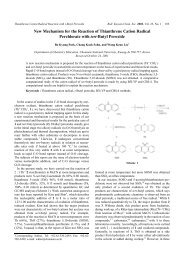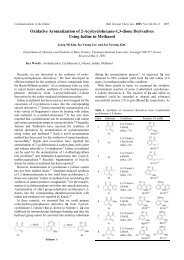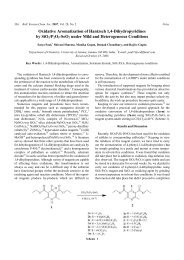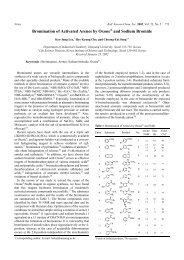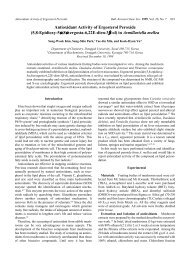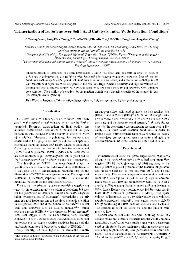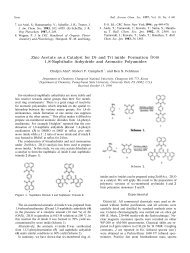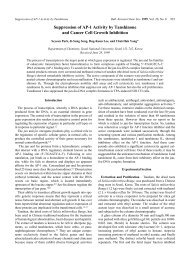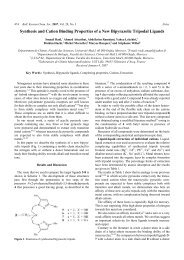One-Pot Synthesis of Naphth[2',3':4,5]imidazo[1,2-a]pyridine-6,11
One-Pot Synthesis of Naphth[2',3':4,5]imidazo[1,2-a]pyridine-6,11
One-Pot Synthesis of Naphth[2',3':4,5]imidazo[1,2-a]pyridine-6,11
Create successful ePaper yourself
Turn your PDF publications into a flip-book with our unique Google optimized e-Paper software.
Notes Bull. Korean Chem. Soc. 2002, Vol. 23, No. 12 1845<br />
<strong>One</strong>-<strong>Pot</strong> <strong>Synthesis</strong> <strong>of</strong> <strong>Naphth</strong>[<strong>2'</strong>,<strong>3'</strong>:4,5]<strong>imidazo</strong>[1,2-a]<strong>pyridine</strong>-6,<strong>11</strong>-diones from<br />
2-Amino-3-chloro-1,4-naphthoquinone and Pyridine Derivatives<br />
Yong Sook Lee and Kee-Jung Lee *<br />
Department <strong>of</strong> Chemical Engineering, Hanyang University, Seoul 133-791, Korea<br />
Received September 10, 2002<br />
Key Words : <strong>Naphth</strong>[<strong>2'</strong>,<strong>3'</strong>:4,5]<strong>imidazo</strong>[1,2-a]<strong>pyridine</strong>-6,<strong>11</strong>-diones, 2-Amino-3-chloro-1,4-naphthoquinone,<br />
NBS, Pyridine derivatives<br />
Dioxonaphthal<strong>imidazo</strong><strong>pyridine</strong> derivatives such as naphth-<br />
[<strong>2'</strong>,<strong>3'</strong>:4,5]<strong>imidazo</strong>[1,2-a]<strong>pyridine</strong>-6,<strong>11</strong>-dione and 9-methylnaphth[1',<strong>2'</strong>:4,5]<strong>imidazo</strong>[1,2-a]<strong>pyridine</strong>-5,6-dione<br />
are<br />
interesting chemical entities both as a chromophoric 1 and a<br />
pharmacological agent for treating diseases related to venous<br />
insufficiency and/or inflammatory edema. 2 Most <strong>of</strong> the early<br />
methods developed for their synthesis are reactions <strong>of</strong> 2-<br />
chloro-3-hydroxy-, 2-chloro-3-ethoxy- and 2-chloro-3-acetoxy-<br />
1,4-naphthoquinones with 2-amino<strong>pyridine</strong>s, 3 thermolysis<br />
<strong>of</strong> 3-azido-2-chloro-1,4-naphthoquinone in excess <strong>of</strong><br />
<strong>pyridine</strong> 1 and condensation reaction <strong>of</strong> 2,3-dichloro-1,4-<br />
naphthoquinones with 2-amino<strong>pyridine</strong> using phase transfer<br />
catalyst. 4<br />
Recently, Pérez-Pérez and co-workers reported 5 that the<br />
reactions <strong>of</strong> 6-amino-1-benzyluracil 1 with N-bromosuccinimide<br />
(NBS) in <strong>pyridine</strong> at 80 ºC afforded 6-amino-1-<br />
benzyl-5-bromouracil 2 and 1-benzyl-1H,3H-pyrido[2,1-<br />
f]purine-2,4-dione 4 via intermediate dibromo compound 3<br />
(Scheme 1). With their results in mind, we tried to apply this<br />
methodology to the synthesis <strong>of</strong> naphth[<strong>2'</strong>,<strong>3'</strong>:4,5]<strong>imidazo</strong>-<br />
[1,2-a]<strong>pyridine</strong>-6,<strong>11</strong>-diones 10 by the reaction <strong>of</strong> 2-amino-3-<br />
chloro-1,4-naphthoquinone 5 with NBS followed by in situ<br />
reaction with <strong>pyridine</strong> derivatives.<br />
The known 2-amino-3-chloro-1,4-naphthoquinone 5 was<br />
easily prepared by the reaction <strong>of</strong> 2,3-dichloro-1,4-naphthoquinone<br />
with ammonim hydroxide. 6 The reaction <strong>of</strong> 5 with 2<br />
equivalents <strong>of</strong> NBS in acetonitrile at room temperature for<br />
10 minutes followed by in situ reaction with 5 equivalents <strong>of</strong><br />
<strong>pyridine</strong> at reflux for 2 hours led to 55% yield <strong>of</strong> naphth-<br />
[<strong>2'</strong>,<strong>3'</strong>:4,5]<strong>imidazo</strong>[1,2-a]<strong>pyridine</strong>-6,<strong>11</strong>-dione together with<br />
15% <strong>of</strong> unreacted 2-amino-3-chloro-1,4-naphthoquinone.<br />
Attempts were made to extend this reaction to other <strong>pyridine</strong>s<br />
such as γ-picoline, ethyl isonicotinate, 4-t-butyl<strong>pyridine</strong>, 4-<br />
<strong>pyridine</strong>carboxaldehyde and isoquinoline (Table 1). Introducing<br />
excess <strong>of</strong> NBS (3 equivalents) and <strong>pyridine</strong> (10<br />
equivalents) to improve the product yield was not successful.<br />
A plausible mechanism for the transformation <strong>of</strong> 5 into 10<br />
is shown in the Scheme 2. 5 The reaction supposed to be<br />
initiated by bromination <strong>of</strong> 5 with NBS to give dihalo<br />
compound 6. 7 The second step should involve the nucleophilic<br />
substitution <strong>of</strong> bromine atom by <strong>pyridine</strong> to generate<br />
7, that, by elimination <strong>of</strong> BrCl, should give the intermediate<br />
Table 1. <strong>Naphth</strong>[<strong>2'</strong>,<strong>3'</strong>:4,5]<strong>imidazo</strong>l[1,2-a]<strong>pyridine</strong>-6,<strong>11</strong>-dione 10a-e<br />
and <strong>Naphth</strong>[<strong>2'</strong>,<strong>3'</strong>:4,5]<strong>imidazo</strong>[2,1-a]isoquinoline-8,13-dione 10f<br />
Prepared<br />
Substrate<br />
Reaction<br />
time (h)<br />
% Yield a Product<br />
Pyridine 2 55 (15)<br />
γ-Picoline 1 23 (50)<br />
4-t-Butyl<strong>pyridine</strong> 4 43 (10)<br />
Ethyl isonicotinate 2 22 (50)<br />
4-Pyridinecarboxaldehyde 3 20 (52)<br />
Scheme 1<br />
* Corresponding Author. E-mail: leekj@hanyang.ac.kr<br />
Isoquinoline 2 32 (30)<br />
a Parentheses values are yields <strong>of</strong> recovered starting materials.
1846 Bull. Korean Chem. Soc. 2002, Vol. 23, No. 12 Notes<br />
Scheme 2<br />
ylide 8. The positive charge in the <strong>pyridine</strong> facilitates a<br />
nucleophilic attack in the α-position <strong>of</strong> the <strong>pyridine</strong> to<br />
generate 9, that is oxidized to afford the naphth[<strong>2'</strong>,<strong>3'</strong>:4,5]-<br />
<strong>imidazo</strong>[1,2-a]<strong>pyridine</strong>-6,<strong>11</strong>-diones 10.<br />
Structural elucidation <strong>of</strong> 10 was accomplished on the basis<br />
<strong>of</strong> spectral data reported in the literature. 1 In the mass spectra<br />
<strong>of</strong> 10, the molecular ions (base peak) are observed. The<br />
successive lose <strong>of</strong> carbon monoxide molecules from the<br />
molecular ion is suggestive <strong>of</strong> the presence <strong>of</strong> two carbonyl<br />
groups as part <strong>of</strong> ring structure and their IR spectra show two<br />
carbonyl absorptions.<br />
In summary, an efficient synthesis <strong>of</strong> naphth[<strong>2'</strong>,<strong>3'</strong>:4,5]-<br />
<strong>imidazo</strong>[1,2-a]<strong>pyridine</strong>-6,<strong>11</strong>-diones has been performed by<br />
the reaction <strong>of</strong> 2-amino-3-chloro-1,4-naphthoquinone with<br />
NBS in the presence <strong>of</strong> <strong>pyridine</strong> derivatives.<br />
Experimental Section<br />
All reagents and solvents were reagent grade or were<br />
purified by standard methods before use. Silica gel 60 (70-<br />
230 mesh ASTM) used for column chromatography was<br />
supplied by E. Merck. Analytical thin layer chromatography<br />
was perfomed on silica gel with fluorescent indicator coated<br />
on aluminium sheets. Melting points were taken using an<br />
Electrothermal melting point apparatus and are uncorrected.<br />
Microanalyses were obtained using a Carlo Erba EA <strong>11</strong>80<br />
element analyzer. Mass spectra were obtained using a<br />
ThermoQuest Polaris Q mass spectrometer operating at 70<br />
eV. Infrared spectra were recorded on a Nicolet Magna 550<br />
FTIR spectrometer. The 1 H NMR spectra were measured on<br />
a Gemini 300 spectrometer. All chemical shifts are reported<br />
in parts per million (δ) relative to tetramethylsilane.<br />
The 2-amino-3-chloro-1,4-naphthoquinone 5 was prepared<br />
following the literature procedure. 6<br />
General Procedure for the Preparation <strong>of</strong> <strong>Naphth</strong>-<br />
[<strong>2'</strong>,<strong>3'</strong>:4,5]<strong>imidazo</strong>[1,2-a]<strong>pyridine</strong>-6,<strong>11</strong>-diones 10. To a<br />
solution <strong>of</strong> 2-amino-3-chloro-1,4-naphthoquinone (5, 1.03 g,<br />
5 mmol) in 40 mL <strong>of</strong> dry acetonitrile was added NBS (1.78<br />
g, 10 mmol). The mixture was stirred at r.t. for 10 min., the<br />
corresponding <strong>pyridine</strong> (25 mmol) was added, and the<br />
resulting mixture was heated at reflux for the time indicated<br />
in Table 1. After cooling to room temperature the solvent<br />
was removed on a rotavapor and the residue was partitioned<br />
between aqueous 10% HCl solution and dichloromethane.<br />
The dichloromethane layer was washed with water and the<br />
solvent was removed after drying over MgSO 4 , and the<br />
residue was chromatographed on silica gel column and<br />
eluted with hexane-EtOAc 4 : 1 to give 10 and the recovered<br />
starting material 5. The yields <strong>of</strong> 10a-10f are listed in<br />
Table 1.<br />
<strong>Naphth</strong>[<strong>2'</strong>,<strong>3'</strong>:4,5]<strong>imidazo</strong>[1,2-a]<strong>pyridine</strong>-6,<strong>11</strong>-dione<br />
(10a). Mp 285-286° (Lit. 1 290°); IR (KBr) 1685, 1642,<br />
1580, 1506, 1394, 1320, 1215 cm −1 ; 1 H NMR (CDCl 3 ) δ<br />
7.24-7.28 (m, 1H), 7.59-7.65 (m, 1H), 7.63-7.79 (m, 2H),<br />
7.93-7.96 (m, 1H), 8.24-8.33 (m, 2H), 9.43 (d, J = 6.7 Hz,<br />
1H); MS m/z (rel intensity) 248 (M + , 100), 220 (28), 192<br />
(35), 191 (<strong>11</strong>).<br />
3-Methylnaphth[<strong>2'</strong>,<strong>3'</strong>:4,5]<strong>imidazo</strong>[1,2-a]<strong>pyridine</strong>-6,<strong>11</strong>-<br />
dione (10b). Mp 326-328° (Lit. 1 330°); IR (KBr) 1679,<br />
1637, 1595, 1507, 1394, 1313, 1218 cm −1 ; 1 H NMR (CDCl 3<br />
+ TFA) δ 2.81 (s, 3H), 7.71-7.73 (d, J = 6.4 Hz, 1H), 7.98-<br />
8.03 (m, 3H), 8.36-8.41 (m, 2H), 9.64 (d, J = 6.7 Hz, 1H);<br />
MS m/z (rel intensity) 262 (M + , 100), 234 (23), 233 (13),<br />
206 (18), 205 (23).<br />
3-t-Butylnaphth[<strong>2'</strong>,<strong>3'</strong>:4,5]<strong>imidazo</strong>[1,2-a]<strong>pyridine</strong>-6,<strong>11</strong>-<br />
dione (10c). Mp 289-290°; IR (KBr) 1689, 1638, 1580,<br />
1506, 1409, 1324, 1277, 1227, 1200 cm −1 ; 1 H NMR (CDCl 3<br />
+ TFA) δ 1.55 (s, 9H), 7.98-8.04 (m, 3H), 8.18 (s, 1H), 8.38-<br />
8.43 (m, 2H), 9.68 (d, J = 7.0 Hz, 1H); MS m/z (rel<br />
intensity) 304 (M + , 46), 289 (100), 261 (28).<br />
Anal. Calcd. for C 19 H 16 N 2 O 2 : C, 74.98; H, 5.30; N, 9.20.<br />
Found: C, 74.71; H, 5.12; N, 8.89.<br />
3-Carbethoxynaphth[<strong>2'</strong>,<strong>3'</strong>:4,5]<strong>imidazo</strong>[1,2-a]<strong>pyridine</strong>-<br />
6,<strong>11</strong>-dione (10d). Mp 240-243° (Lit. 1 246°); IR (KBr) 1720,<br />
1685, 1650, 1592, 1514, 1398, 1316, 1219 cm −1 ; 1 H NMR<br />
(CDCl 3) δ 1.47 (t, J = 7.1 Hz, 3H), 4.49 (q, J = 7.1 Hz, 2H),<br />
7.79-7.83 (m, 3H), 8.25-8.35 (m, 2H), 8.59 (s, 1H), 9.45 (d,<br />
J = 7.0 Hz, 1H); MS m/z (rel intensity) 320 (M + , 100), 292<br />
(75), 275 (50), 264 (18), 219 (19), 191 (19).<br />
3-Formylnaphth[<strong>2'</strong>,<strong>3'</strong>:4,5]<strong>imidazo</strong>[1,2-a]<strong>pyridine</strong>-6,<strong>11</strong>-<br />
dione (10e). Mp 319-322°; IR (KBr) 1774, 1693, 1374,<br />
1297, <strong>11</strong>92 cm −1 ; 1 H NMR (CDCl 3 + TFA) δ 8.01-8.06 (m,<br />
2H), 8.29 (d, J = 7.0 Hz, 1H), 8.40-8.45 (m, 2H), 8.92 (s,<br />
1H), 9.93 (d, J = 7.3 Hz, 1H), 10.3 (s, 1H); MS m/z (rel<br />
intensity) 276 (M + , 100), 275 (45), 219 (17), 191 (29), 164<br />
(13).<br />
Anal. Calcd. for C 16H 8N 2O 3; C, 69.57; H, 2.92; N, 10.14.<br />
Found: C, 69.41; H, 2.80; N, 9.87.<br />
<strong>Naphth</strong>[<strong>2'</strong>,<strong>3'</strong>:4,5]<strong>imidazo</strong>[2,1-a]isoquinoline-8,13-dione<br />
(10f). Mp 314-315° (Lit. 1 320°); IR (KBr) 1677, 1646, 1596,<br />
1518, 1405, 1347, 1223 cm −1 ; 1 H NMR (CDCl 3 + TFA) δ 7.99-<br />
8.12 (m, 4H), 8.22 (s, 2H), 8.37-8.43 (m, 2H), 8.81 (d, J =
Notes Bull. Korean Chem. Soc. 2002, Vol. 23, No. 12 1847<br />
7.3 Hz, 1H), 9.44 (d, J = 6.7 Hz, 1H); MS m/z (rel intensity)<br />
298 (M + , 100), 270 (20), 242 (31), 241 (19), 207 (17).<br />
References<br />
1. Ayyangar, N. R.; Lugade, A. G.; Tilak, B. D. Indian J. Chem.<br />
1979, 18B, 236.<br />
2. Boutherin-Falson, O.; Desquand-Billiald, S.; Favrou, A.; Finet,<br />
M.; Tembo, O.; Torregrosa, J.-L.; Yannic-Arnoult, S.; Joubert, C.<br />
WO 9721709 (1997); C. A. 127, 121731.<br />
3. Mosby, W. L. J. Org. Chem. 1961, 26, 1316.<br />
4. E1-Shafei, A. K.; Sultan, A.; Vernin, G. Heterocycles 1982, 19,<br />
333.<br />
5. Pérez-Pérez, M.-J.; Priego, E.-M.; Jimeno, M.-L.; Camarasa, M.-<br />
J. Synlett 2002, 155.<br />
6. Ruan, M.-D.; Wu, Z.-J.; Fan, W.-Q.; Zhou, X.-J. Heterocycles<br />
1994, 37, 323.<br />
7. Isolation <strong>of</strong> dihalo compound 6 was unsuccessful due to rapid<br />
decomposition to 5.


![One-Pot Synthesis of Naphth[2',3':4,5]imidazo[1,2-a]pyridine-6,11](https://img.yumpu.com/21946252/1/500x640/one-pot-synthesis-of-naphth2345imidazo12-apyridine-611.jpg)
